ShodhKosh: Journal of Visual and Performing ArtsISSN (Online): 2582-7472
|
|
Prehistoric Kashmir: Unraveling the Cultural Heritage of Neolithic Artifacts
Naheed Ahmed 1![]()
![]() ,
Yogambar Singh Farswan 2
,
Yogambar Singh Farswan 2![]()
![]() ,
Sunil Singh 1
,
Sunil Singh 1![]()
![]()
1 Research
Scholar in Ancient Indian History, Culture and Archaeology, Department of
Ancient Indian History, Culture and Archaeology, Hemvati Nandan Bahuguna
Garhwal University (A Central University) Srinagar Garhwal 246174, Uttarakhand,
India
2 Professor
in Environmental Archaeology, Department of History including Ancient Indian
History, Culture & Archaeology Hemvati Nandan Bahuguna Garhwal University
(A Central University), Srinagar Garhwal-246174, Uttarakhand, India
|
|
ABSTRACT |
||
|
In the present
paper, we have carried out a systematic study of the important archaeological
remains recovered from the Neolithic sites in the Kashmir valley that were
excavated by the Archaeological Survey of India. It is also evident from the
earlier studies carried out by various Scholars that more than fifty-five
Neolithic sites were discovered in the Jammu and Kashmir region, and two in
the Ladakh region. The Neolithic
remains were found at nine sites during the field work but among these only
four Neolithic sites were systematically excavated extensively. These are
Burzahom, Gufkral, Simthan and Kanispur. The archaeological artifacts
reported from these Neolithic sites in the Kashmir valley were mainly
pottery, terracotta objects, metal objects, stone objects, paste Objects and
semi-precious stones. In the present paper, an analytical estimation of
Neolithic culture such as the structural remains, ceramic assemblages, metal
objects, terracotta objects, shell objects, bone objects, and stone objects
are studied. The information provided in the present paper about the
Neolithic culture in Kashmir is based on the excavations of these four
Neolithic archaeological sites in Kashmir Valley such as Burzahom, Gufkral,
Simthan and Kanispur. Many other Neolithic settlements are reported in the
Kashmir valley which are still waiting for the excavation. |
|||
|
Received 03 February 2024 Accepted 08 May 2024 Published 15 May 2024 Corresponding Author Naheed
Ahmed, naheedahmed92@gmail.com DOI 10.29121/shodhkosh.v5.i1.2024.950 Funding: This research
received no specific grant from any funding agency in the public, commercial,
or not-for-profit sectors. Copyright: © 2024 The
Author(s). This work is licensed under a Creative Commons
Attribution 4.0 International License. With the
license CC-BY, authors retain the copyright, allowing anyone to download,
reuse, re-print, modify, distribute, and/or copy their contribution. The work
must be properly attributed to its author.
|
|||
|
Keywords: Kashmir Neolithic, Cultural Materials, Sites |
|||
1. INTRODUCTION
It noticed that the Neolithic Revolution, a broad range of changes that seem to have occurred independently in many parts of the world. This "Neolithic package" encompassed the development of agriculture, the domestication of animals, and the transition from a hunter-gatherer to a settled existence Blois & Van Der Spek (1982). As an improvement on the three-age scheme, Sir John Lubbock coined the term "Neolithic" in 1865. Farming first emerged in the Epipalaeolithic Near East some 12,000 years ago and then spread to other regions of the world. It persisted in the Near East up until the Chalcolithic (Copper Age), which began roughly 6,500 years ago (4500 BC) and was characterized by the development of metallurgy and preceded the Bronze Age and Iron Age. Blois & Van Der Spek (1982), 14
Neolithic culture flourished in China until around 2000 BC, when the pre-Shang Erlitou culture emerged Chang (1982) and it did the same in Scandinavia until around 2000 BC. Cavalli-Sforza et al. (1994)
2. Neolithic in South and East Asia
Around 7,000 BC, in the province of Baluchistan, Pakistan, settled life, which included the switch from foraging to farming and pastoralism, began Fisher (2018). There is evidence of the domestication of wheat and barley at the Mehrgarh site in Baluchistan, which was swiftly followed by the domestication of goats, sheep, and cattle. Wright (2009) The oldest (and first early Neolithic) evidence for the drilling of teeth in vivo (with bow drills and flint tips) was discovered at Mehrgarh, it was reported in the scientific journal Nature in April 2006. Coppa et al. (2006).
The Neolithic period in South India started about 6500 BC and lasted until the beginning of the Megalithic transition period in about 1400 BC. Ash mounds, which first appeared in the Karnataka region around 2500 BC and eventually spread to Tamil Nadu, represent the South Indian Neolithic. Asouti & Fuller (2007)
The earliest archaeological sites in East Asia date to the Nanzhuangtou culture (9500–9000 BC), Pengtoushan culture (7500–6100 BC) Xiaoyan (2012), and Peiligang civilization (7000– 5000 BC). The Neolithic Beifudi site, located in Hebei Province, China, close to Yixian, contains artifacts from a civilisation that coexisted with the Cishan and Xinglongwa cultures between 6000 and 5000 BC. This bridges the archaeological gap between the two Northern Chinese cultures. The Neolithic artifacts at the location span two phases and cover a total area of more than 1,200 square yards (1,000 m2; 0.10 hectare) during the excavation process (New Archaeologica Discovery and Research, 2005)
The Longshan civilization flourished in northern China's middle and lower Yellow River region between 3000 and 1900 BC. Most of the region's population fell precipitously towards the end of the third millennium BC, and many of the bigger cities were abandoned, presumably as a result of environmental change related to the end of the Holocene Climatic Optimum Liu & Chen (2012).
3. General geography/Physiographical setting
The most remote regions of northern India are the union territory of Jammu & Kashmir and the union territory of Ladakh. The Himalayan Mountains comprise the majority of both union territories. The states of Punjab and Himachal Pradesh border it on the south. The Union Territory of Jammu and Kashmir and the Union Territory of Ladakh share an international boundary with Pakistan in the west and China in the east. Jammu, Kashmir, and Ladakh, which are made up of the three territories of Jammu, the Kashmir Valley, and Ladakh, was one state before Ladakh was separated from Jammu and Kashmir. Both union territories enjoyed special autonomy under Article 370 of the Indian Constitution. Jammu serves as the state's winter capital, while Srinagar serves as its summer capital. Tens of thousands of Hindu pilgrims visit Jammu each year to explore the numerous shrines and the Kashmir valley's famed gorgeous mountainous terrain. Ladakh is recognised for its solitary mountain beauty and Buddhist culture and is commonly referred to as "Little Tibet".
The Pleistocene loess deposits in Kashmir Valley, which are thought to be the thickest and most widespread in the Indian subcontinent, are found in the foothills of the Western Himalayas. These deposits serve as the most reliable and significant record of terrestrial Palaeo-environmental changes. The Pir-Panjal Range and the Himalayas, which are both in the southwest, flank the valley Agrawal (1982), 2.
In terms of Palaeo-Climatic and archaeological investigations, it poses a special challenge. It includes a sedimentary profile of several hundreds of meters and stunning exposures brought by erosion and tectonic activity. The area has experienced several cold-warm oscillations, which have caused glaciers to wax and wane, plant belts to shift, changes in sedimentology and geomorphology, and stable isotopic differences in physical and chemical deposits Agrawal (1982), 2.
According to geological and geographical area, the "Pir Panjal range was further up-thrusted to impound the Himalayan drainage, thereby generating a large lake" around four million years ago (hence, Mya) Agrawal et al. (1990), 70. Thus, the ascent of the Pir Panjals is what led to the creation of the Karewa Lake. The Lower Karewa deposits were raised by the Pir Panjals' continued ascent, which also pushed the lake in the direction of the Himalayan slope. Later, the Pir Panjals were pierced by the Baramulla fault, and the Jhelum drained the lake.
Around three mya, Pir Panjal rose to a height that could block the southwest monsoon from reaching the valley, causing the climate to shift from subtropical to temperate. By 200 thousand years ago, "the primordial lake shrunk and migrated to the Himalayan side, exposed the Karewa strata of the SSW," according to this source (South Southwest). Around 85 years ago, the Jhelum River began to emerge, draining the final lake sediments Agrawal et al. (1990), 70. Kashmir offers a sequence of continuous geological records of undistributed lacustrine deposits dating back roughly four mya, which may be unique in Asia. The Kashmiri relic sediments have long drawn researchers from a variety of fields, including geology, palaeontology, paleo-botany, and archaeology De Terra & Paterson (2003), 234.
The first settled life in Kashmir can be traced near 3000 BC during the Neolithic period. The people of the early farming community of Kashmir get protection from cold weather used to live in pit dwellings. Along with the development of agriculture, the cultivation of plants and animals, as well as the production of various varieties of pottery, a new sector of the stone tool industry evolved. More than fifty archaeological sites dotting Kashmir's landscape along its length and width show the Neolithic culture of Kashmir Kennedy (2000), Singh (2008).
Burzahom was the first Neolithic settlement in Kashmir, according to De Terra and Patterson. They also mentioned a village in Nunar (Ganderbal), where a Neolithic level similar to the Burzahom Neolithic deposit was discovered at a depth of seven feet De Terra & Paterson (2003), 234.
There are almost more than fifty Neolithic sites reported so far in Kashmir Valley five in the Jammu region and two in the Ladakh region. Neolithic remains were found at nine sites, including Gufkral, Begagund, Jayadevi-Udar, Hariparigom, Olchibag, Panzgom, Pampur, Thajiwor, and Sombur, as a result of further ASI examinations conducted along the Jhelum valley from Anantnag to Pampur. Pottery in the form of coarse grey, burnished, combed, and gritty red ware, mace heads, and celts are all part of the cultural assemblage from these sites. Gufkral and Olchibag among these sites revealed pit homes. At Sempur, pit homes were also noted. Burzahom-type megaliths were spotted in Begagund, Gufkral, Hariparigom, and Pampur IAR: Archaeological a Review, (1962-63), 9. Additionally, pit homes were discovered at a location on Damodar Udar, around 10 kilometres southwest of Srinagar IAR: Archaeologicala Review, (1961-62), 98. On a steep terrace near Wular Lake, a polished stone axe and harvester were reportedly discovered from GurahomaSangri and were similar to those discovered at Burzahom IAR: Archaeologicala Review, (1961-62), 98. The studies in Indian Archaeology: A Review mention megalithic stones, typical Neolithic stone tools and pottery, and several archaeological sites in Kashmir. Sixteen new Neolithic sites from Kashmir were reported as discovered by Pant and colleagues Pant et al. (1982), 38.
These sites are known for their distinctive ceramic industries, which produce ochreous burnished ware, red ware, combed ware, coarse grey ware, and gritty red ware. Along with the normal Neolithic goods, a lithic industry with enormous discoidal cores, borers, flake knives, and scrapers was discovered.
The Neolithic sites in Kashmir Valley exhibit both ceramic and a-ceramic (without pottery) occupancy stages. Pant and others reported on the pottery and a-ceramic Neolithic occurrences from places like Kuladur (Baramulla) and Khan Sahab (Budgam) Pant et al. (1982), 38. Pyathpathur (Baramulla), Malpur, Huin, Batachar, and Nilnag were also claimed to have evidence of the Neolithic culture's aceramic period. At these locations, the stone industry is represented by thermally fractured stones, tools manufactured on flakes and cores, as well as grinders and pounders. These sites often contain backed knives, long, parallel-sided double scrapers, and waisted tools that are linked with the Neolithic aceramic phase Pant et al. (1982), 38.
Map 1

|
Map 1 Map
Showing Neolithic Settlements in Kashmir Valley. Source Fonia
(1960-71) |
Material culture is a genuine source to reconstruct the socio-economic aspects of the past human society. All kinds of material culture symbolize the performance of Neolithic societies and are the real representatives of their manufacturers and consumers. Material culture is an important source of defining many factors that play a fundamental role in cultural processes like environment, availability of raw material, technology, organization of production, ideology, and belief system. Thus, cultural materials are authentic records of ancient societies that play a significant part in archaeological research.
In the Kashmir valley, more than fifty Neolithic sites (Map-1) have been discovered by archaeologists. These settlements are located on the elevated Karewa deposits overlooking rivers and lakes. Out of these sites, only four sites have been excavated in Jammu and Kashmir valley so far namely Burzahom (IAR: Archaeological a Review, (1960-61), 11, IAR: Archaeologicala Review, (1961-62), 17-21, IAR: Archaeological a Review, (1962-63), 9-10, IAR: Archaeological a Review, (1964-65), 13, IAR: Archaeological a Review, (1965-66), 19, IAR: Archaeological a Review, (1968-69), 10, IAR: Archaeological a Review, (1970-71), 16, IAR: Archaeological a Review, (1980-81), 24, Gufkral IAR: Archaeological a Review, (1998-99), 19-25, Kanispur (IAR: Archaeological a Review, (1998-99), 30-48) and Semthan (IAR: Archaeological a Review, (1983), 21). The excavations of this site have revealed ample evidence that throws light on the material culture of the Neolithic period in the Kashmir valley including structural remains, ceramic assemblages, metal objects, terracotta objects, shell objects, bone objects and stone objects. The present study contains a brief study of the material culture.
4. House Structure
The excavations have provided a remarkably accurate picture of the lives of the pioneering farmers in the valleys. During the winter, the Neolithic people lived in pits and shelters, which were dug into a loosely compacted deposit of Karewa, probably to protect themselves from the cold winds. It was noticed that these dwelling pits had several post-holes on their peripheries, suggesting the presence of a superstructure made up of either wood or grass covering them. The presence of hearth, ash, charcoal, ceramic assemblage, animal bones, stone tools, and human burials in the pits is indicative of the fact that these pits were used for residential purposes. The steps or stairs were also used for entry and exit points of pits. Remains of pits and associated materials also indicated that for living shallow and deep pits were most commonly used by prehistoric people during the summer and winter seasons respectively. Shreds of evidence of mud and mud brick structures are also recovered from the later phases of this period.
The excavation at Burzahom revealed several rectangular and square pits, drainage systems, post-holes, hearth, etc. It was observed in the period first that the dwelling pits were scooped out in the Karewas (Figure 1 to Figure 2). These pits are circular or oval on the plan, narrow at the top and wide at the base. The floors of these are flat with sidewalls occasionally plastered with mud. The largest oval pit measured is 2.74 meters in diameter at the top and 4.57 meters at the bottom. In addition, squares or rectangular pit chambers were also found. Analysis of the pit chambers indicated that they are abounding in the central portion of the mound while the circular and oval-shaped pits are found on the periphery of the mound. The Study of Period II also clarified that a new structural plan evolved during this period. The semi-subterranean pits and pit chambers were plastered and filled up with mud and red ochre. The mud and mud brick structures and well-arranged post-holes on the floor were also noticed. It was interesting to note that hearths, grinding stones, and mullers were the necessary components of these houses (IAR: Archaeological a Review, (1964-65), P-13. As evidenced by the large, deep pits carved out of the underlying floor levels of Period II to support megalithic structures, Period III was characterized by the introduction of new concepts into the sites. Massive megalithic complexes, symbolized by menhirs, are another characteristic of the era. Menhirs are enormous, free-standing stones that weigh tonnes. These stones were built at the end of the Neolithic period, according to the cultural sequence. As a result, it appears that just six stones are in place—five of them are vertical and the sixth is flat De Terra (1942), 485.
The Gufkral site consists of Large and compact dwelling pits, cut into loess deposits, circular or rectangular on the plain with a small mouth and broad bottom (Figure 3 and Figure 4). The diameter of these dwelling pits ranges from 3.80 meters to 1.50 meters at the top. The big dwelling pits are usually from an earlier phase and the maximum depth of these ranges from 0.2 meters to 0.3 meters deep. A number of the post-holes and hearths were recovered around the pits. The evidence of mud chunks with reed impressions indicates the superstructure above the pits. The hearths were found rectangular-shaped in the earlier phase, while during the later phase, rectangular as well as oval-shaped hearths were recovered. It is also observed that the floor and walls of the pits were plastered with mud. The remains of the mud platforms and pit dwelling are found in the second phase and the settlement of this period evidenced the presence of a 0.5 to 0.7 meters thick floor made up of a mixture of yellow clay and chunam. In this cultural phase, rectangular dwelling pits were also recovered. Period 1C is represented by a 0.7-meter to 0.8-meter thick whitish floor. The main characteristic feature of this period is the representation of a large number of refuse pits and dumps (IAR: Archaeological a Review, (1980-81), 20-23).
Figure 1

|
Figure 1 Rectangular Pit of Burzahom. Source Author |
Figure 2

|
Figure 2 Pit Showing Niche and Post Holes in Burzahom. Source Author |
Figure 3

|
Figure 3 Pit at Gufkral. Source Author |
Figure 4
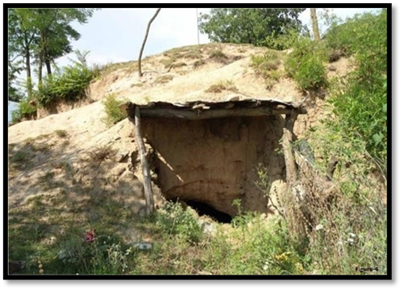
|
Figure 4 Opening of an Underground Pit at Gufkral. Source Author |
Analytical analysis revealed that the evidence of the circular pits was also found at the Kanispur archaeological site (Figure 7). The deposit was approximately 0.15 to 0.2 meters in thickness benefits any ceramic industry. Evidence of four successive floor levels and a rectangular house were noticed in the period second. At the same time, a large number of bone tools, stone tools, and pottery were recovered on the floor level and evidence of a diaper pebble wall was also found at this site. The decorated terracotta tiles with the pattern of the large disc are found on the slope of the Kanispur (KNP-2). An average of 1.6 meters to 2-meter ceramic Neolithic level deposit was recovered from Kanispur (KNP-3) but no evidence of structural remains of Neolithic culture was found in the KNP-3 area.
Figure 5
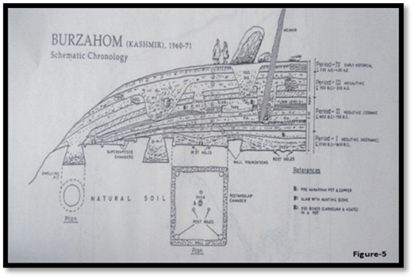
|
Figure 5 Burzahom- Schematic Section Looking East Showing Cultural Deposits (After Sharma (2000) |
Figure 6
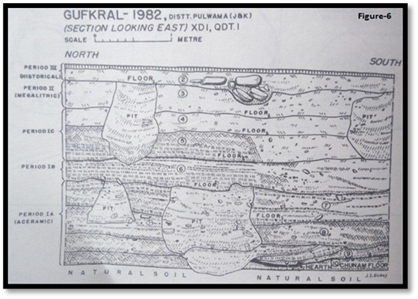
|
Figure 6 Gufkral, Jammu and Kashmir- Section (After Sharma (2000)) |
Figure 7
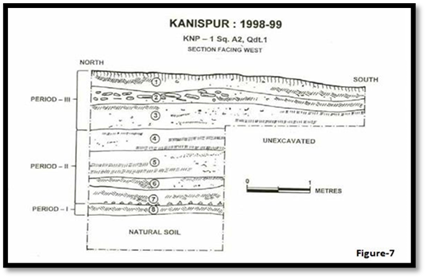
|
Figure 7 Kanispur, Jammu and Kashmir- Section Looking Section Facing the West Showing Cultural Deposits (After IAR: Archaeological a Review, (1998-99)). |
5. Ceramic Assemblage
As we know ceramic assemblages were a basic need of human beings and therefore, it is the most important key to unlocking various aspects of past settlements. It is evident from the literary data Parry (2016) that the earliest settlers of Kashmir were not familiar with ceramic assemblages. However, however with passage of time they learned the technology of manufacturing ceramic assemblage. In earlier stages, most of the ceramic assemblages were handmade with the features of fabric and surface finished coarse but later on, the wheel technology came into existence which expanded the ceramic manufacturing practices. The main shapes included were a dish, bowl, vase, and high-neck jars. It is also noticed that the majority of the pots had mat impressions on their base, which indicated that after making the pots, the potter kept them on the hand-woven floor mats. Decorated paintings are also seen on a number of the pots. In this sequence, a horned deity painting was identified on a globular pot and it is very similar to the characteristics of the pots recovered from Gumla in Pakistan and Kot-Diji in India Mani (2008), 230.
Important types and features of the Kashmir Neolithic
pottery
1) Hemispherical bowl with ring base.
2) Bowls without curved sides, which is probably a stand.
3) Deep bowls are cups with straight sides or outcurved sides.
4) Funnel-mouthed vessels.
5) Small elongated vessels with a bulging belly, cylindrical neck, and ring base.
6) Large high-necked jar in steel grey ware.
7) Small, wide-mouthed vessel with a beaded rim.
8) A small thick-based dish or plate.
Important pottery and their forms reported by various Scholars from the Kashmir Neolithic (Figure 8, Figure 9, Figure 10, Figure 11, Figure 12, Figure 13) are briefly described as follows:
·
Redware
Redware was the main ceramic industry of the Kashmir Neolithic. The redware pottery was reported from Kanispur and Burzahom. The redware is found in the form of pots, dish-on-stands, vases, bowls, plates, basins, spouted bowls, and cooking pots. The redware pottery reported from Kanispur in large numbers as compared to the other pottery.
·
Red dull ware
The red dull ware pottery is recovered from Kanispur Mani (2000). The red dull ware is found in the form of pots, dish-on-stands, vases, and bowls.
·
Red gritty ware
Gritty Redware is the most characteristic feature of Megalithic pottery. A few characteristics of this ware have been found at Burzahom and Gufkral in the Neolithic period. The total ceramic assemblage is handmade and generally in strip technique. In some cases, the necks have been turned on a slow wheel. The principal shapes are Kashmir tsoads (small pitchers), voars (lotas), noats (pitchers), Pyala (bowls) type, a few smaller taok (dish) types, and Mathas type (storage vessels). Red gritty ware is also reported from the neolithic sites in south Kashmir like Hariparigam, Begun, Dadsar, Olchibag, Sombur, Panggom and Waztal during the exploration conducted by the University of Kashmir in 2009 Bandey (2009), 74.
·
Buff ware
The buff ware is only reported from Kanispur, Mani (2000). The buff ware pottery mainly was recovered in the form of a vase.
·
Grey ware
The greyware pottery is reported from Period 1B and Period 1C of the Gufkral. Fine and coarse grey ware was also reported from Kanispur. Grey ware pottery was mainly handmade and mat-impressed designs are also found on the ceramic. Greyware was more dominant in the Kanispur 1B period.
·
Burnished Grey Ware
The Burnished greyware is the main feature of the Neolithic period and is reported from the Burzahoam and the late Neolithic period of the Gufkral. The fabric of the ceramic is medium to fine and mat impressions are found. The principal shapes are the long-necked jars, vases with noticeable necks and rounded bodies, basins, bowls, lotas,s, and dishes. Burnished greyware is also reported from the neolithic sites in south Kashmir like Hariparigam, Begun, Dadsar, Olchibag, Sombur, Panggom and Waztal during the exploration conducted by the University of Kashmir in 2009 Bandey (2009), 74.
·
Steel Grey ware
Steel greyware pottery is reported from the Burzahom.
·
Coarse Grey ware
The coarse greyware is reported from the Kanispur, Burzahom and Gufkral. The surfaces of coarse greyware are dull grey. Coarse grey ware is also reported from the neolithic sites in south Kashmir like Hariparigam, Begun, Dadsar, Olchibag, Sombur, Panggom and Waztal during the exploration conducted by the University of Kashmir in 2009 Bandey (2009), 74.
·
Fine Grey ware
The fine grey ware is reported from the Burzahom and this fine grey ware has been fired in different temperatures to get various shades such as ashy grey, dull grey, dull brown, and dark grey. The principal shapes of fine grey ware are Ledji (handi type), Kashmiri Noat (pitcher-ghara), Voar (lota) type, and Tsoad (a small pitcher). However, a few numbers of large vessels were recovered from Burzahom. Fine grey ware is also reported from the neolithic sites in south Kashmir like Hariparigam, Begun, Dadsar, Olchibag, Sombur, Panggom and Waztal during the exploration conducted by the University of Kashmir in 2009 Bandey (2009), 74.
· Blackware
The blackware potteries are reported from the Kanispur site.
·
Burnished blackware
The burnished blackware pottery is reported from the Late Neolithic period of the Gufkral and Burzahom. This ware was hand-made as well as wheel-turned pottery.
·
Rough thick dull ware
The rough thick dull ware is reported from the Late Neolithic period of the Gufkral.
Table 1
|
Table 1 Various Types of Pottery Objects from the Different Neolithic Sites in Kashmir Valley |
|||||||||||
|
Objects |
Burzahom |
Gufkral |
Kanispur |
Hariparigam |
Begund |
Dadsar |
Olchibag |
Sombur |
Panzgom |
Brah |
Waztal |
|
Redware |
|
-- |
+ |
-- |
-- |
-- |
-- |
-- |
-- |
-- |
-- |
|
Red
dull ware |
-- |
-- |
|
-- |
-- |
-- |
-- |
-- |
-- |
-- |
-- |
|
Red
gritty ware |
+ |
|
-- |
+ |
+ |
+ |
+ |
+ |
+ |
+ |
+ |
|
Buff
ware |
-- |
-- |
|
-- |
-- |
-- |
-- |
-- |
-- |
-- |
-- |
|
Greyware |
-- |
|
|
-- |
-- |
-- |
-- |
-- |
-- |
-- |
-- |
|
Burnished Grey Ware |
+ |
+ |
-- |
+ |
+ |
+ |
+ |
+ |
+ |
+ |
+ |
|
Steel
grey ware |
+ |
-- |
-- |
-- |
-- |
-- |
-- |
-- |
-- |
-- |
-- |
|
Coarse
grey ware |
+ |
+ |
+ |
+ |
+ |
+ |
+ |
+ |
+ |
+ |
+ |
|
Fine
grey ware |
+ |
-- |
|
+ |
+ |
+ |
+ |
+ |
+ |
+ |
+ |
|
Black ware |
-- |
-- |
+ |
-- |
-- |
-- |
-- |
-- |
-- |
-- |
-- |
|
Burnished black ware |
+ |
+ |
-- |
-- |
-- |
-- |
-- |
-- |
-- |
-- |
-- |
|
Rough thick
dull ware |
-- |
+ |
-- |
-- |
-- |
-- |
-- |
-- |
-- |
-- |
-- |
Figure 8
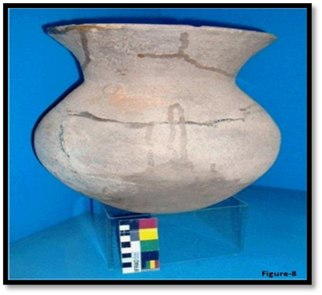
|
Figure 8 Pottery of Burzahom Source Author |
Figure
9
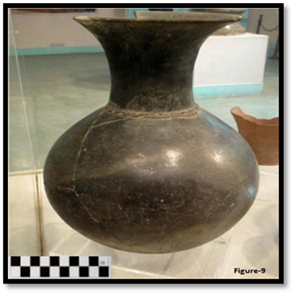
|
Figure 9 Pottery of Burzahom Source Author |
Figure 10
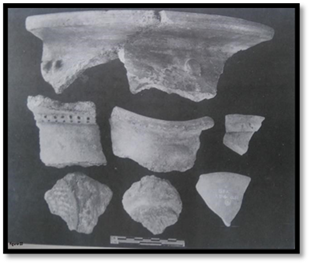
|
Figure 10 Gufkral Pottery, Period-IB (after Sharma (2000)) |
Figure 11
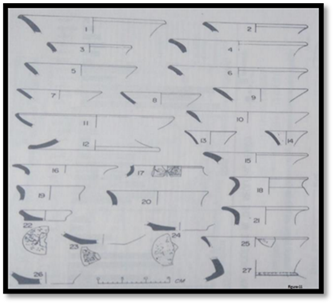
|
Figure 11 Gufkral, Jammu, and Kashmir-Pottery from Period IB-Neolithic (after Sharma (2000)) |
Figure 12

|
Figure 12 Burzahom Pottery from Periods I and II (after Sharma (2000)) |
Figure 13
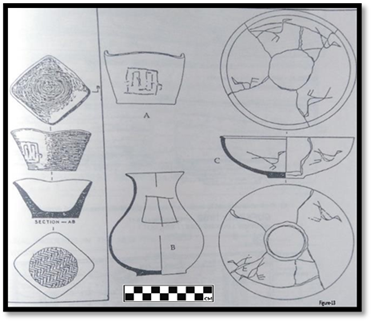
|
Figure 13 Burzahom- Burnished Grey Ware, Period 1, Squire, and Graffiti (after Sharma (2000)) |
6. Stone objects
The stone objects played an important role in Kashmir's Neolithic culture. The stone objects comprised polished axes, harvesters, chisels, pounders, querns, polishers, perforated discs, and grinders (Figure 14, Figure 15, Figure 16, Figure 17, Figure 18, Figure 19, Figure 20, Figure 21). Some of the important stone objects reported from Neolithic sites of Kashmir Valley are described below:
·
Stone Celt
A large number of the stone Celts are recovered from the Neolithic sites of Kashmir. The stone Celt was used by Neolithic people as a tool for hunting and cutting purposes. A total of twenty-eight stone Celts are reported from the Kanispur, Gufkral, and Burzahom archaeological sites. However, in addition to stone Celts, different types of unfinished Celts and a huge number of Celt fragments are also recovered during the excavation of these sites. The Celt's stone tools are fully polished and are about 10 cm long with single and double edges. The percentage of stone Celts recovered from archaeological sites and their specific features indicate that this tool played a significant role in the everyday life of Neolithic people Sharma (2000).
·
Mace Head or Ring Stones
A large number of mace headstone tools are recovered during the excavation of Burzahom and Gufkral but most of the mace heads are obtained in broken condition. The size of these tools is large and small. Morphological analysis of these tools revealed that most probably the mace-heads were used as a personal weapons as well as dispatching the wounded game in the Neolithic culture. The mace heads recovered from the Neolithic cultural site of Kashmir are mainly of two types i.e. disc mace heads and club mace heads. The mace head has an hourglass section in the centre and a biconvex section the outer ring with sharply bevelled edges Sharma (2000).
·
Pounders
Pounders are heavy stone tools and are generally used to grind or mix different types of materials. These stone tools are mainly reported from Period 1A, Period 1B, and the late Neolithic period of the Gufkral Neolithic site.
·
Querns
The quern tool consists of two circular stones and this stone tool was used for grinding. Querns stone tools are recovered from all cultural periods of the Gufkral archaeological site.
·
Piecers-cum-scrapper
The piercer-cum-scrapper is recovered from Period 1A, Period 1B, and the late Neolithic period of the Gufkral. Scrappers were used for butchering animals and removing the meat from the hides.
·
Stone Axe
The stone axe stone tools were recovered from the archaeological site Burzahom (Sharma (2000), 51). The size of these stone tools is nearly 15 cm. long, having an ovoid section, round hammered butt, fully polished, and straight ground edge. A polished stone axe is considered one of the most important tools of the Neolithic era. It is used for heavy as well as light types of work.
·
Burnishing stone
The two burnishing stones are reported from the Burzahom.
·
Grinder
The four grinder stones are reported from the Burzahom.
·
Hoes
Most hoes are found in incomplete forms. Ten hoes are reported from periods first and second of Burzahom. The irregularly rounded shaped, ventral face, roughly pecked surfaces, and slightly chipped butt are the main feature of Neolithic hoes.
·
Sawing Knives
Nine specimens of sawing knives are recovered from Burzahom. It is flake knives and working edges are invariably sharp and double-edged.
·
Chisels
Fourteen different types of chisels are reported from the Burzahom. The chisels are found generally in medium to large sizes.
·
Double Edge points
A total of 444 double edges of stone and bone tools were recovered from the excavation of Burzahom in Period I, period IIA, and Period IIB of Burzahom. (Fonia (1960-71))
·
Adze
A total of 71 adzes are recovered from the Neolithic period of the Burzahom. The adzes are classified mainly based on their functions related to the forms, section, variations in the butt, and sharpness of the edge.
7. Harvester or Perforated Knives and Double Haled Harvester
Harvesters' types of tools have been recovered both in bone and stone. A total of 28 stone harvesters are reported from periods IIA and II B of the Burzahom. Harvesters are generally found in rectangular pieces and the opposite thin, having two perforations from both sides. Besides this, the double-haled harvester is also reported from the Late Neolithic period of the Gufkral Sharma (1982), 54-55.
·
Bells
The stone bells were also recovered from the Late Neolithic period of the Gufkral and Kanispur. Sharma (1982), 54-55.
·
Stones
points
The 14 stones points are reported from the Gufkral.
Table 2
|
Table 2 Various Types of Stone Objects that Reported from the Neolithic Sites in the Kashmir Valley |
|||
|
Objects |
Burzahom |
Gufkral |
Kanispur |
|
Stone
Celt |
+ |
+ |
+ |
|
Mace
head |
+ |
+ |
-- |
|
Pounders |
-- |
+ |
-- |
|
Querns |
-- |
+ |
-- |
|
Piecer-cum-scraper |
-- |
+ |
-- |
|
Stone
axe |
+ |
+ |
-- |
|
Burnishing
stones |
+ |
-- |
-- |
|
Grinder |
+ |
-- |
-- |
|
Hoes |
+ |
-- |
-- |
|
Sawing
knives |
+ |
-- |
-- |
|
Chisel |
+ |
-- |
-- |
|
Double
edge points |
+ |
-- |
-- |
|
Adze |
+ |
-- |
-- |
|
Harvester
or perforated knives and |
+ |
+ |
-- |
Figure 14
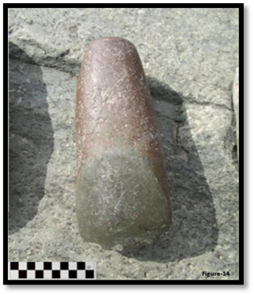
|
Figure 14 Stone Tool from Burzahom. Source Author |
Figure 15
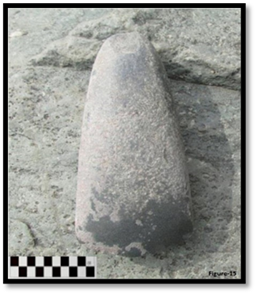
|
Figure 15 Stone tool from Burzahom. Source Author |
Figure 16
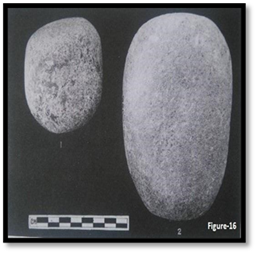
|
Figure 16 Gufkral-Period IC- -Pounders (after Sharma (2000)) |
Figure 17
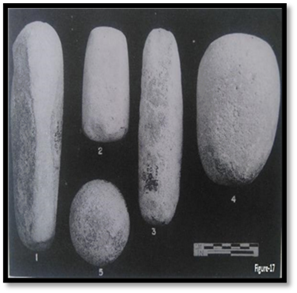
|
Figure 17 Gufkral-Pestles and Pounders-Period IA, ph., 2-1, 2, 3, -Pestles Period IB-4 Pounder; 5- Ball (after Sharma (2000)) |
Figure 18
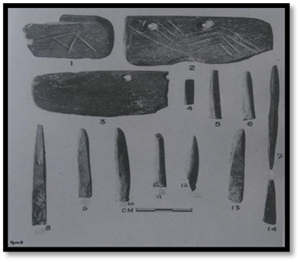
|
Figure 18 Gufkral- Stone Points- Period IA- ph, 3-7; pd. IB- 8,9; Period IC- 4,5,6,12,13; Harvester-, pd. IC-2,3; pd.II- 1 (after Sharma (2000)) |
Figure 19
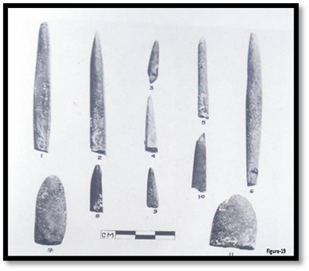
|
Figure 19 Gufkral Stones Objects Period-IA, Points-2, 3, 4-Phase-1; 1, 5, 6, 8, 9-Phase 2; 10; Phase 3; Scrapper-7 Phase 2, 11 Phase 3 (after Sharma (2000)) |
Figure 20
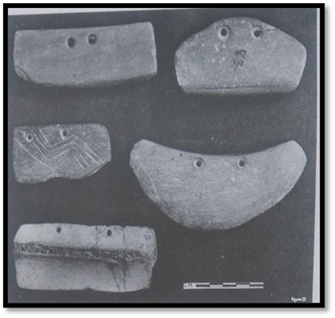
|
Figure 20 Stone and Bone Harvester- Burzahom- 1, 2, 4-Stone, 5. 5 Bone; Gufkral-30 Stone (after Sharma (2000)) |
Figure 21

|
Figure 21 Gufkral- Ring Stone- Period IA, Ph.3-2; Period II-1, 3, 5. (after Sharma (2000)). |
8. Semi-precious stones
Semiprecious stone objects have an important role in understanding the economic aspects of ancient society. However, the carnelian and agate have a significant part in the bead industry of the Neolithic period in Kashmir. Literary data revealed that a total of 886 carnelian beads (59.30 per cent) and 87 agate beads (34.53 percent) are reported from the Neolithic period of the Burzahom, however, it is interesting that 864 carnelian beads were recovered from a pot of the second period of Burzahom Fonia (1960-71). No carnelian bead was recovered from the third period. The carnelian beads are found in different shapes such as circular barrel, circular, cylindrical, truncated bicone circular, bicone circular, concave bicone circular, convex bicone circular, truncated, and hexagonal. Out of 87 agate beads, 79 beads are found in long barrel circular, one each standard lenticular two in round eye-beads, rectangular tabular, short lenticular, oval eye-bead, fish-shaped eye-bead, oval eye-bead, and leech-shaped Fonia (1960-71).
The carnelian “comma” and “tiger” shaped pendant on light green zade with a pointed end and a straight flat top having a hale are reported from the Gufkral Sharma (2000), 97. Earlier studies indicated that only the carnelian and agate beads were reported from the Burzahom and Gufkral.
Table 3
|
Table 3 Various Types of Semi-Precious Stone Tools that Reported from the Neolithic Sites in the Kashmir Valley |
|||
|
Objects |
Burzahom |
Gufkral |
Kanispur |
|
Carnelian
beads |
+
|
+
|
--
|
|
Agate
beads |
+
|
--
|
--
|
|
Light
green zade |
--
|
+
|
--
|
Figure 22
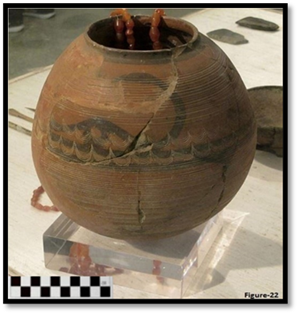
|
Figure 22 Pot, Excavated from Burzahom
with a Painting of a Wild Goat with Long Horns and Hanging Ears with Beads. |
·
Bone and Ivory Objects
Bone and ivory objects have also played an important role in the day-to-day life of the Kashmir Neolithic people. It was noticed that the bones and ivory objects industry was equally rich as compared to the other industries. A brief description of bones and ivory objects is mentioned below along with the (Figure 23, Figure 24, Figure 25, Figure 26, Figure 27):-
·
Needles
The needles made up of bones are reported from the Neolithic sites Kanispur, Gufkral, and Burzahom and these Needles are of four sub-types i.e.
1) Simple needles, having about 12 cm. in length, round section, and flattened end.
2) Small needles in round and pointed shapes.
3) Round needles, round shapes throughout but flat at one end and Double perforation, with a flattened tapering body Sharma (2000), 53.
Some polished bone needles are also recovered from the site of Kanispur and Gufkral.
·
Harpoons
A harpoon is a long thin weapon with a sharp pointed end and a rope tied to it that is used to catch sea animals. Harpoons were recovered from the Neolithic site Burzahom but the number was only two. Generally, these are recovered in three sub-types i.e. (i) Harpoons with barbs on both sides, (ii) Harpoons with symmetrically carved and (iii) Harpoons with barbs mostly on one side Sharma (2000), 54.
·
Bone Points
Archaeological studies revealed that a large number of bone points were recovered from the Neolithic sites of Kashmir, i.e. forty-nine from the Burzahom, and four from the Kanispur. The morphological analysis of the points indicated that these are of three sub-types such as (i) Thin sharp and projected points, (ii) Sharp points with a rounded and flattened body, and (iii) Butt ground points.
From the Burzahom archaeological site, two double-edged bone points were also recovered and four bone points were reported from the Kanispur Sharma (2000), 54.
·
Scrapers
A scraper is a flint implement with a sharp edge used for scraping material such as hide or wood and scrappers were a significant tool of Neolithic society. It is assumed that this tool was used to butcher the animals as well as to remove the meat from the hides and three subtypes of bone scrapper are reported from the Burzahom i.e. (i) Heavy, horn tip, sharpened and burnished, (ii) Medium and polishing long bones and (iii) Light thin and flat Fonia (1960-71).
·
Arrowheads
Arrowheads are the sharp point of the end part of an arrow especially used for shooting or hunting purposes. From the excavation of Burzahom and Gufkral in Kashmir valley, some arrowheads were also recovered and these are of two sub-types, such as (i) Shouldered and (ii) Rounded.
Besides this, the splinter, and horns (mostly arrowheads) were reported from the Gufkral by Sharma in 2000.
·
Awls
Awls is a small pointed tool used for piercing holes, especially in leather. Two awls are reported from period 1A of the Gufkral Sharma (2000), 97
·
Pen-shaped points
The pen-shaped bone point is reported from the Burzahom. Fonia (1960-71).
·
Dagger type Single Edged Medium Point
A dagger is a weapon with a short pointed blade, used for stabbing. A total of 72 single-edged and medium-pointed dagger types were reported from period first, period second (A), and period second (B) of the Burzahom.
·
Double edge points (knitters)
Fonia (1960-71) reported a total of 218 knitters from Period I, Period II A and II B of the Burzahom excavation.
·
Composite tool
The composite tools (a bone made on along, hallow bone?) are reported from the Burzahom. It is like a cobbler’s poker, along with a pointed tool with a long handle and evidently for stitching leather Fonia (1960-71)
·
Bones beads
21 bone beads are reported from the Neolithic period of the Burzahom (Burzahom:
Excavation report (1960-71), however, one bone bead is also recovered from the Gufkral. (Sharma 1981:9)
·
Other bone objects
In the other bone objects category, 27 small and long bone tools, splinters, and horns (mostly arrowheads) are reported from Period 1A of the Gufkral.
Figure 23
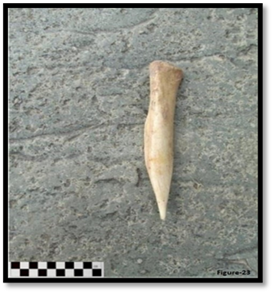
|
Figure 23 Bone Tool from
Burzahom. Source Author |
Figure 24
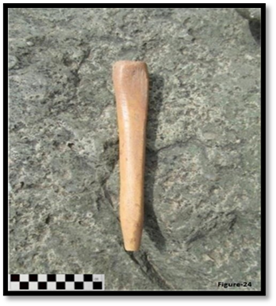
|
Figure 24 Bone Tool from
Burzahom. Source Author |
Figure 25
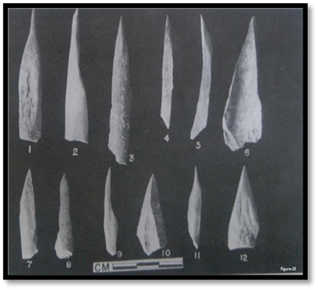
|
Figure 25 Gufkral- Bone Tools, Period IA, Phase 1points- 3,4,5,9; Scrapper-6,10; Arrowhead- 7,11,2; Awls-2,8; Borer-1(after Sharma (2000)) |
Figure 26
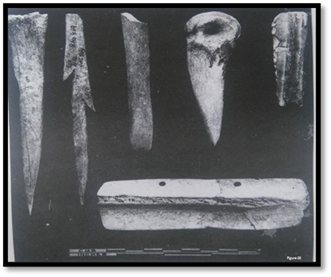
|
Figure 26 Burzahom-Bone Tools, 5- Harvester on the Bone (after Sharma (2000)) |
Figure 27

|
Figure 27 Burzahom- Bone Tools (after Sharma (2000)) |
Table 4
|
Table 4 Types of Bone Objects Reported from the Neolithic Sites of the Kashmir Valley |
|||
|
Objects |
Burzahom |
Gufkral |
Kanispur |
|
Needles and polished bone needles |
+ |
+ |
+ |
|
Harpoons |
+ |
-- |
-- |
|
Bone points |
+ |
-- |
+ |
|
Scrapers |
+ |
-- |
-- |
|
Arrowhead |
+ |
+ |
-- |
|
Awls |
-- |
+ |
-- |
|
Pen-shaped point |
+ |
-- |
-- |
|
Pendant |
-- |
+ |
-- |
|
Composite tool |
+ |
-- |
-- |
|
Small and long bone tool |
-- |
+ |
-- |
|
Splinter and horn |
-- |
+ |
-- |
|
Dagger type single edge medium point |
+ |
-- |
-- |
|
Knitters (double edge points) |
+ |
-- |
-- |
|
Well-polished bone tool |
-- |
+ |
-- |
|
Bone objects with four obiquemiesed
(simultaneously) grooves |
-- |
+ |
-- |
|
Bone beads |
+ |
+ |
-- |
·
Metal objects
The copper objects were more common during the Neolithic period and they were recovered from the Neolithic period at Burzahom, Gufkral, and Kanispur respectively. Some of the metal
Objects recovered from the Kashmir Neolithic are briefly described below:-
· Chisels
Various types of chisels which are different in size and shape are reported from the Neolithic sites in the Kashmir valley. These metallic chisels are recovered from both the Neolithic sites i.e. from Kanispur as well as from the Burzahom site.
Ear-nose rings and Hairpins
The four metallic ear and nose rings are reported from the Kanispur and eight copper hairpins are also recovered along with rings from the Gufkral Sharma (1982), 9.
· Needles
The 44 metallic needles recovered were reported from the Burzahom and many others from Kanispur and Gufkral.
· Antimony Rod
A total of 34-39 Antimony rods were reported from the Burzahon.
·
Arrow Heads
Seven complete metallic arrowheads were reported from the Burzahom Fonia (1960-71). It is found distinctively, barbed, and tanged shaped.
· Harpoons
The 2 copper harpoons are reported from the Burzahom.
·
Spear Head
The 2 spearheads are reported from the Burzahom. Fonia (1960-71)
·
Bangles (complete and broken)
Complete fragments of 14-16 copper bangles are recovered from period IIB and period III of Burzahom. Bangles pieces are also reported from the Kanispur.
·
Complete ring
A complete ring (thin compressed section with overlapped end) is reported from the period IIA of the Burzahom. Fonia (1960-71)
·
Bar Celt
A complete bar-Celts was reported from Period III of the Burzahom site. Fonia (1960-71)
·
Complete pin
A 40 to 43 number of complete pins with different shapes and sizes are reported from the Burzahom. Fonia (1960-71) However, two copper pins from the Kanispur and seven copper pins from the Gufkral were also recovered Sharma (1982), 9
·
Coil Head
The metallic flattered coil head was recovered from the Gufkral.
Table 5
|
Table 5 Various Types of Metal Objects that Reported from the Kashmir Neolithic Sites |
|||
|
Objects |
Burzahom |
Gufkral |
Kanispur |
|
Chisels |
+ |
-- |
+ |
|
Ear and nose ring and hairpin |
-- |
+ |
+ |
|
Needles |
+ |
+ |
+ |
|
Antimony rod |
+ |
+ |
-- |
|
Arrowhead |
+ |
+ |
-- |
|
Harpoons (thrusting type) |
+ |
-- |
-- |
|
Spearheads |
+ |
-- |
+ |
|
Fragmentary wire piece |
+ |
-- |
-- |
|
Bangles (complete and broken) |
+ |
-- |
+ |
|
Complete ring (coil-like) |
+ |
-- |
-- |
|
Bar Celt |
+ |
-- |
-- |
|
Complete pin |
+ |
-- |
+ |
|
Complete nail |
+ |
-- |
-- |
|
Coil head |
-- |
+ |
-- |
Figure 28
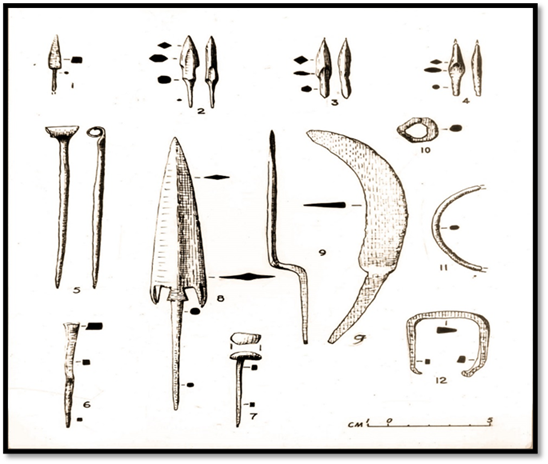
|
Figure 28 Metallic Objects Reported from Burzahoam-1-Tang Tip, 2-Arrowhead, 3,4- Sharp and Broken Arrowhead, 5,6,7- Complete Nail, 8-Spearhead, 9, Complete Sickle, 10- Complete Ring, 11- Broken Fragmentary Bangle, 12- Complete Clamp (Fonia-Burzahom Excavation Report) |
·
Terracotta objects
“Terracotta objects” (Figure 29 and Figure 30) are essentially dominating items and significant sources of information regarding philosophy and traditions. A large number of terracotta objects are reported from the Neolithic sites in Kashmir such as terracotta bangles, terracotta pendants, and terracotta marbles. The description of terracotta objects is given below: Bangles: Bangles are a very traditional Indian ornament and represent solitary status. The nine terracotta bangles are reported from the Gufkral Sharma (1982). A few terracotta bangles are also recovered from Kanispur. V-shaped pendant: The V-shaped terracotta pendant is reported from the Gufkral. Sharma (2000), 97 Broken Terracotta marbles: Two dozen broken marbles are reported from the Kanispur and six terracotta marbles from the Gufkral. Coil-head: The terracotta coil-head is reported from the late Neolithic period of the Gufkral. Terracotta beads: Two terracotta beads are found at the Burzahom site. Fonia (1960-71).
Table 6
|
Table 6 Terracotta Objects Reported from the Neolithic Sites of the Kashmir Valley |
|||
|
Objects |
Burzahom |
Kanispur |
Gufkral |
|
Bangles
pieces |
-- |
+ |
+ |
|
V-shaped
pendant |
-- |
-- |
+ |
|
Broken
terracotta marble |
-- |
+ |
+ |
|
Coil-head |
-- |
-- |
+ |
|
Terracotta
beads |
+ |
-- |
+ |
Figure 29
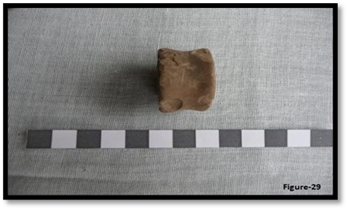
|
Figure 29 A Terracotta Bobbin from Burzahom (after Yatoo (2009)). |
Figure 30
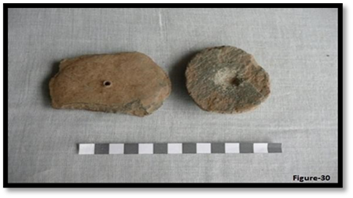
|
Figure 30 Schist Disks from Burzahom (after Yatoo (2009)). |
·
Paste objects
It is evident from the literature that steatite beads were popular during the Neolithic period of Kashmir. A total of five steatite beads from the Burzahoam, two from the Kanispur, and four from Gufkral were recovered during the excavation of these sites respectively. The steatite beads found from the Neolithic site of Kashmir are categorized as cylinder circular, concave bicone, and barrel circular-shaped Sharma (1982), 9.
Figure 31
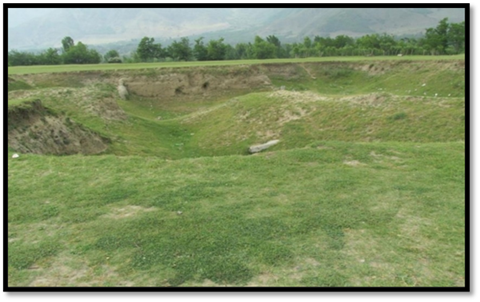
|
Figure 31 Excavated Portion of
Burzahom Source Author |
Figure 32
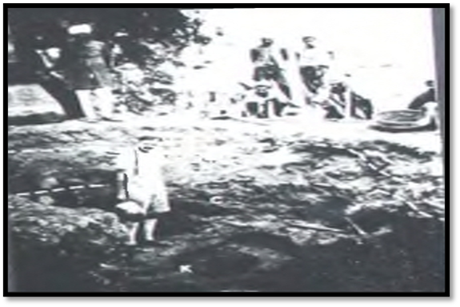
|
Figure 32 Excavation at Burzahom by Helmut De Terra (after: R. S. Fonia (1960-71)) |
9. Discussion and Conclusions
The archaeological excavations provided an important stratigraphical sequence of ancient culture in the Kashmir valley, such as aceramic Neolithic culture (C.3000-2500 BC), Early Neolithic culture (C.2500-2000 BC), Late Neolithic culture (C.2000-1700 BC), Megalithic culture (C.1700-1000 BC), Historical culture and Medieval culture. The earlier settled life in the Kashmir valley can be traced back to about 3000 BC. The location of the Neolithic settlements in Kashmir is very interesting. A cluster of more than fifty Neolithic sites are located in the Kashmir valley five Neolithic sites are reported in the Jammu region and two in the Ladakh Region. But out of these more than fifty-five Neolithic sites in the Union territory of Jammu and Kashmir only a single Site namely “Burzahom” is under the control of the Archaeological Survey of India and the rest of the Archaeological sites are under the control of Union territory Archives, culture and Archaeology department. This is one of the major drawbacks in the Union territory of Jammu and Kashmir where no systematic excavation or exploration is being conducted. Archaeological studies suggested that the ecological conditions of the Kashmir valley played an important role in the origin as well as expansion of the settled life of earlier farming communities Ahmed & Farswan (2022). Geomorphological features showed that the region has a large concentration of alluvial deposits. The rivers and lakes might have played an important role by providing high-quality agricultural land as well as irrigation facilities, along with the provision of different varieties of wild animals and plants.
This region was also an important resource area for various types of metal ores and minerals. Therefore, it is assumed that the Kashmir valley provided ample opportunities for the beginning and development of the Neolithic culture in this region. It is significant to note that the people of Neolithic culture were permanently settled here and successfully developed their traditions, customs, and ritual activities. They have established a successful trade network and cultural contact with contemporary cultures. The results described above and presented in Table 1, Table 2, Table 3, Table 4, Table 5, and Figure 1, Figure 2, Figure 3, Figure 4, Figure 5, Figure 6, Figure 7, Figure 8, Figure 9, Figure 10, Figure 11, Figure 12, Figure 13, Figure 14, Figure 15, Figure 16, Figure 17, Figure 18, Figure 19, Figure 20, Figure 21, Figure 22, Figure 23, Figure 24, Figure 25, Figure 26, Figure 27, Figure 28, Figure 29, Figure 30, Figure 31, Figure 32 revealed an interesting and unexpected phenomenon.
10. Concluding remarks
The dish-on stand, perforated jar, carnelian bead, agate bead, blades of semi-precious stones, and copper objects clearly show well-developed and advanced cultural activities in Kashmir Neolithic culture. The pits dwelling, post holes, mud brick structures, stone pounders and mullers are common features of this culture. Which were commonly used by the Neolithic peoples in Kashmir valley. The information about the Neolithic culture in Kashmir is based on systematic excavations at the four sites, Burzahom, Gufkral, Semthan and Kanispur. The small scale exaction at Burzahom was done in 1936, then again a small-scale excavation was conducted in 1939 by D.Terra and Patterson and last a full-fledged systematic excavation was conducted by the Archeological Survey of India from 1960 to 1971, Similarly, a small-scale excavation was done at Semthan by archaeological Survey of India in 1977 and then again a small scale excavation is conducted at Semthan in 1981-83 under the supervision of R.S.Bisht Superintending Archaeologist. Kanispur also witnessed a small-scale excavation under the supervision of B.R. Mani in 2000 and at last similarly these three sites Gufkral also witnessed a symmetrically small excavation in 1981 by the prehistoric branch of the Archaeological Survey of India. After 2000 there was no symmetrically exaction conducted or done by the Archaeological Survey of India or by the Union Territory of Jammu and Kashmir Archaeological Department. Most of the Archaeological is destroyed by the locals and we lost our prestigious past. The Archaeological Survey of India as well as the Department of Union Territory of Jammu and Kashmir Archives, Culture and Archaeology should take steps to protect the Archaeological sites in Kashmir Valley and also conduct a systematic exploration and excavation. There are more than fifty Neolithic sites in Kashmir Valley which are still waiting to be excavated and explored. After these excavations and explorations, we can highlight the all cultural aspects of the Neolithic culture and ancient culture and the cultural contacts of Neolithic peoples with their contemporary culture in Kashmir valley.
CONFLICT OF INTERESTS
None.
ACKNOWLEDGMENTS
None.
REFERENCES
Agrawal, D. P. (1982). The Kashmir Karewas: A Multidisciplinary Perspective. Man and
Environment, 6, 1-4.
Agrawal, D.P., Dodia, R.,
Kotlia, B.S., Razdan, H., & Sahni, A. (1990).
The PlioPleistocene Geologic and Climatic Record of the KashmirValley, India: A
Review and New Data. Man and Environment, 15, 57-72.
Ahmed, N., & Farswan, Y.S. (2022). Study of Vanishing remains of Kashmir Neolithic Culture: An Overview. Journal of History, Archaeology and Architecture, 1(1), 35-46.
Asouti, E., & Fuller, D. Q. (2007). Trees and Woodlands of South India: Archaeological Perspectives, 282.
Bandey, A. A. (2009). Prehistoric Kashmir Archaeological History of Palaeolithic &
Neolithic Cultures, New Delhi, Dilpreet Publishing House, 74.
Blois, L. D., & Van Der Spek, R. J. (1982). An Introduction to the Ancient World, 14.
Cavalli-Sforza, L. L., Menozzi, P., & Piazza, A. (1994). The History and Geography of Human Genes. Princeton, NJ: Princeton University Press, 351.
Chang, K.C. (1982). Studies of Shang Archaeology. Yale University Press, 6-7.
Coppa, A., Bondioli, L., Cucina, A., Frayer, D. W., Jarrige, C., Jarrige, J. -F., Quivron, G., Rossi, M., Vidale, M., & Macchiarelli, R. (2006). Early Neolithic Tradition of Dentistry. Nature. 440 (7085), 755-756. https://doi.org/10.1038/440755a
De Terra, H. (1942). The Megaliths of Bursahom, Kashmir, a New Prehistoric Civilization
from India, American Philosophical Society, 483-504.
De Terra, H., & Paterson, T.T. (2003). The Ice Age in the Indian Subcontinent and Associated Human Cultures: With Special Reference to Jammu, Kashmir, Ladakh, Sind, Liddar & Central, and Peninsular India, New Delhi, Aryan Books, 234.
Fisher, M. H. (2018). An Environmental History of India: From Earliest Times to the Twenty-First Century, Cambridge University Press, 33. https://doi.org/10.1017/9781316276044
Fonia (1960-71). Excavation Report of Burzahom.
IAR: Archaeological a Review,
(1960-61) New Delhi: Archaeological Survey of
India.
IAR: Archaeological a Review,
(1962-63). Archaeological Survey of India, New
Delhi, 9-10.
IAR: Archaeological a Review,
(1964-65). Archaeological Survey of India, New
Delhi, 15.
IAR: Archaeological a Review,
(1965-66). Archaeological Survey of India, New
Delhi, 19-21.
IAR: Archaeological a Review,
(1968-69). Archaeological Survey of India, New
Delhi, 9-10.
IAR: Archaeological a Review,
(1970-71). Archaeological Survey of India, New
Delhi, 17.
IAR: Archaeological a Review,
(1980-81). Archaeological Survey of India, New
Delhi, 21-26.
IAR: Archaeological a Review,
(1998-99). Archaeological Survey of India, New
Delhi, 30-59.
IAR: Archaeologicala Review, (1961-62). Archaeological Survey of India, New Delhi, 16-21.
Kennedy, K. A. R. (2000). God-Apes and Fossils Men: Paleoanthropology of South Asia. University of Michigan Press. https://doi.org/10.3998/mpub.16180
Liu, L., & Chen, X. (2012). The Archaeology of China: From the Late Paleolithic to the Early Bronze Age, Cambridge University Press, 220-251. https://doi.org/10.1017/CBO9781139015301
Mani, B.R. (2000). Excavations at Kanispur: 1998-99 (District Baramulla Kashmir).
Journal of Interdisciplinary Studies in History and Archaeology 10, 1-21.
Mani, B.R. (2008). Kashmir Neolithic and Early Harappan: A Linkage, Pragdhara, 18,
229-247
Pant, R.K., Gaillard, C., Nautiyal, V.,
Gaur, G.S., & Shali, S.L. (1982). Some New
Lithic and Ceramic Industries from Kashmir. Man and Environment 6, 37-40.
Parry, A. (2016). Neolithic Ceramic of Kashmir- A Recent Study of Neolithic Sites of
Southern Kashmir. Kamya Press.
Sharma, A. K. (2000). Early Man in Jammu Kashmir and Ladakh, New Delhi, Agam Kala Prakashan, 5-195.
Sharma, A.K. (1982). Gufkral 1981: An Aceramic Neolithic Site in the Kashmir Valley, Asian
Perspectives XXV 2 (1982-1983), 23-41.
Singh, U. (2008). A History of Ancient and Early Medieval India: From the Stone Age to
the 12th Century, Pearson Education India.
Wright, R. P. (2009). The Ancient Indus: Urbanism, Economy, and Society, Cambridge University Press, 44, 51.
Xiaoyan, Y, (2012). Early Millet Use in Northern China. Proceedings of the National Academy of Sciences. 109 (10), 3726-3730. https://doi.org/10.1073/pnas.1115430109
|
|
 This work is licensed under a: Creative Commons Attribution 4.0 International License
This work is licensed under a: Creative Commons Attribution 4.0 International License
© ShodhKosh 2024. All Rights Reserved.

